AI regulatory violations to drive a 30% jump in tech legal disputes by 2028
Expect more litigation. A new report indicates AI regulatory violations will trigger a 30% rise in legal disputes for tech companies by 2028. For in-house counsel and firms, the docket is about to get heavier across compliance, contracts, privacy, IP, and consumer claims.
What the data shows
- Over 70% of IT leaders say regulatory compliance is a top-three challenge for rolling out GenAI productivity assistants.
- Only 23% are very confident in their ability to manage security and governance for enterprise GenAI deployments.
- 57% of non-US IT leaders report the geopolitical climate at least moderately affects GenAI strategy; 19% say the impact is significant.
- Nearly 60% of those non-US leaders are unable or unwilling to adopt non-US GenAI alternatives.
- Findings are based on inputs from 360 IT leaders involved in generative AI rollouts.
- In a separate poll (489 respondents): 40% hold a positive view of AI sovereignty, 36% neutral; 66% are proactive on sovereign AI strategy; 52% are making strategic or operating model changes because of it.
As Gartner's Lydia Clougherty Jones noted, "Global AI regulations vary widely... This leads to inconsistent and often incoherent compliance obligations, complicating alignment of AI investment with demonstrable and repeatable enterprise value and possibly opening enterprises up to other liabilities."
Why this matters to legal teams
- Enforcement and private actions will climb as new AI rules mature and guidance solidifies.
- Cross-border rollout of GenAI will trigger data transfer, localization, and sovereignty issues that test current contracts and controls.
- Low confidence in governance increases exposure to bias, consumer protection, safety, IP, and privacy claims.
- Vendors' model changes and opaque training data create warranty and indemnity pressure points.
Priority actions for the next 12 months
- Inventory and classify all AI use cases and models (internal and vendor-supplied); map legal bases, data types, and jurisdictions.
- Stand up an AI policy and control framework tied to risk tiers; define RACI across legal, security, data, and product teams.
- Run pre-deployment risk assessments (e.g., DPIA where required) for high-risk uses; document human oversight and redress paths.
- Tighten third-party due diligence: model provenance, training data sources, licensing, safety evaluations, and update cadence.
- Update cross-border data and sovereignty playbooks: data residency, model hosting location, export controls, and vendor alternatives.
- Set bias, safety, and performance thresholds; require test artifacts, model cards, and ongoing monitoring results.
- Build audit trails: prompts, outputs, model versions, guardrails, human approvals, and access logs with retention schedules.
- Refresh incident response for AI-specific failures (hallucination harm, safety breaches, content moderation gaps) and notification duties.
- Align insurance coverage (tech E&O, cyber, media/IP) to AI risks and contractual obligations.
- Brief the board and set recurring reporting on AI risk, incidents, and regulatory exposure.
Contract language to add now
- Acceptable use and data input restrictions (no sensitive categories without approval; no inputs that violate data rights).
- Training and fine-tuning limits (no use of customer data for training without express consent; separation and deletion on termination).
- IP warranties and indemnities covering output rights, training data licenses, and third-party claims.
- Regulatory compliance clause tied to specific regimes (e.g., EU AI Act risk controls, privacy laws) with audit and certification rights.
- Safety, security, and content safeguards with measurable standards and remediation timelines.
- Change management: advance notice of model or hosting changes; ability to pause use or exit if risk profile increases.
- Localization and sovereignty options (EU-only hosting, non-US alternatives, controllable geofencing).
- Subprocessor approvals, transparency on model lineage, and right to review evaluation reports.
- Detailed logging/traceability deliverables; test evidence and explainability artifacts for high-risk uses.
- Clear liability caps, carve-outs for wilful misconduct/IP/privacy, and step-in rights for repeated non-compliance.
Dispute-readiness checklist
- Preservation plan for prompts, outputs, model versions, and human review records.
- Standard expert panel and vendors for AI audits, bias testing, and explainability support.
- Jurisdiction and governing law strategy for multi-market deployments; arbitration vs. courts decision tree.
- Consumer communication templates for AI-assisted features and limitations.
Geopolitics and AI sovereignty: counsel's playbook
- Segment deployments by jurisdiction and sensitivity; offer regional model options where feasible.
- Track localization mandates and state-aid rules; build a fallback plan if a primary model becomes restricted.
- Balance US and non-US vendor exposure; pre-negotiate switch rights and data portability.
Useful references
If your legal team needs to upskill on AI governance and compliance, see curated options by role here: Complete AI Training - Courses by Job.
Your membership also unlocks:






